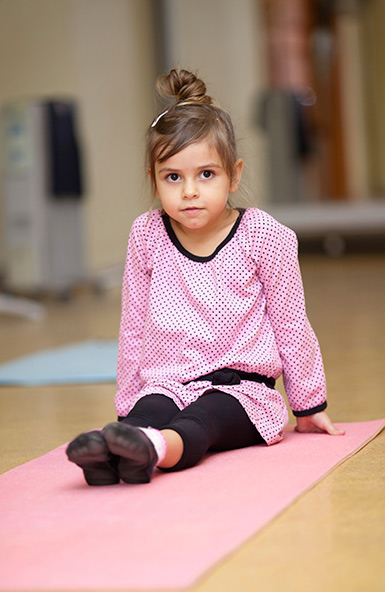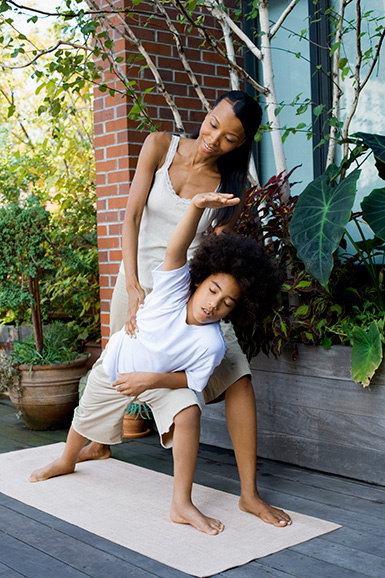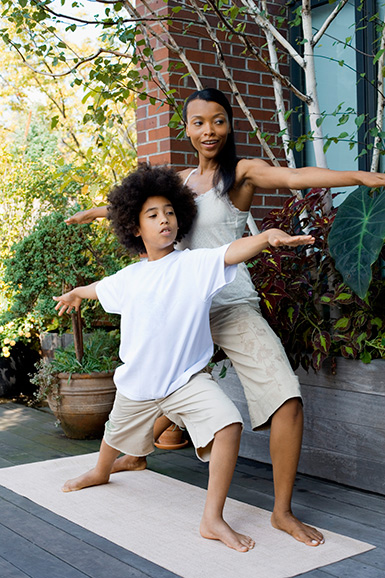The benefits of Kids Yoga include building positive qualities such as self-esteem and respect, promoting physical strength, learning body awareness, and coping methods for stress.
It’s been 14 years since I entered my first yoga class…reluctant, kicking and screaming. A seasoned athlete, I couldn’t imagine what yoga could possibly offer for me besides, perhaps, some nice sitting and humming.
And then it all began. The love affair that would change my life forever.
It wasn’t just Bryan Kest’s asana sequence that had me at “Namaste”—it was his message. Everything he said just rang so true to what I believed. It all made some much sense. It touched me, it moved me, it spoke to me, and it called me in.
Long story short, I was blown away. And all I kept thinking was: “I wish I had found this when I was three instead of 30. How different my life would have been.”
 It was just a few months later that I completed my first 200-hour training, and mini yogis yoga for kids was born. My goal: to provide the children of Los Angeles with all the gifts—and, yes, I’ll go so far as to say enlightenment—that yoga had to offer. I wanted to change some lives. This was 2002 and hundreds of schools summarily dismissed and rejected my offer to come in and teach their students yoga. Seriously. They thought the very concept was ridiculous.
It was just a few months later that I completed my first 200-hour training, and mini yogis yoga for kids was born. My goal: to provide the children of Los Angeles with all the gifts—and, yes, I’ll go so far as to say enlightenment—that yoga had to offer. I wanted to change some lives. This was 2002 and hundreds of schools summarily dismissed and rejected my offer to come in and teach their students yoga. Seriously. They thought the very concept was ridiculous.
Fast forward to 2015, and you’ll be hard-pressed to find a single school in LA without yoga. Yes, the LA mind has opened up (wide) and here’s what you need to know about how to get your children involved and make sure they don’t miss the yoga bus. Here’s what you need to know about how to change your children’s lives.
CHILDREN’S YOGA: A PRIMER
My first fantasies of children’s yoga included rows and rows of angels, sitting in full lotus, eyes closed, faces serene, deeply ensconced in profound meditation.
Okay…so, that’s not exactly what kids’ yoga looks like.
Yoga for kids is down and dirty fun. Yes, it’s meditation and focus and savasana. But even more so, it’s toys and games and songs and books; it’s loud and playful and creative and interactive and sometimes full-contact, and every cool kid thing you can think of rolled up into one big yoga ball.
A children’s yoga class is a place where kids can experiment with their bodies and try new things. Where they can fall without fear of failure and transform something classical and venerable into something integrative and dynamic.
Here’s the first thing you need to know about children’s yoga. Though it all revolves around real yoga (asanas, philosophy, meditation, etc.), it looks very, very different from your typical adult class. So different, in fact, that a strict traditionalist may look at it and mutter under his pranayama that it’s not even yoga. But it is.
Remember, yoga means “yoke.” It is the binding together of one’s mind, body, and spirit into the alignment of pure intention. It is our realest, truest, highest self.
How do we achieve that as adults? We dim the lights, lower our voices, play soft music, light some candles…we disassociate from the noise, the chitta.
But for a child to be one with his or her element, the process is a little different.
Put a child in a dimly lit room with candles and soft music and the first thing s/he will want to do is turn on the lights and make some noise. And then s/he will be scolded and told to quiet down and behave.
No child is in his or her element while being reprimanded, squelched and subdued. Children find their inner peace—their yoga—when they are playing, exploring, and fully expressing themselves. Kids are in their element when they are just being kids. That’s where this whole practice begins.
WHAT TO EXPECT FROM A KIDS’ YOGA CLASS
From a good one, you should expect all the same things you see in your own classes. The same seated meditations, the same asanas, the same savasanas, the same dharma talks…just in a brighter, more exciting, more kid-friendly package.
In a children’s yoga class, you’ll hear a lot more barking in downward facing dog than usual, meowing in cat pose, and mooing in cow face pose.
The chants of kirtan are replaced with the sounds of playground songs, nursery rhymes, and Laurie Berkner albums.
Instead of focusing on your own process and keeping your eyes on your own mat, we work in circles in a mostly interactive format.
Here’s what distinguishes a strong children’s yoga class from Mickey Mouse Playhouse: First, it will be fun and just as creative, with structure and discipline balanced by personal freedom and individuality. It won’t be as unforgiving as ballet or karate where everything has to be done just so, but it will teach the same lessons about self-control and self-confidence. Second, though the presentation will be dramatically different from an adult class, the foundations of the content remain the same. All the postures are real yoga asanas. The children aren’t just playing pantomime, pretending to be animals and calling it yoga. They will be playing games and acting things out within the structure of true postures and practices.
So…all great kids’ yoga classes need great kids’ yoga teachers.


WHAT TO LOOK FOR IN A KIDS’ YOGA TEACHER
Of course you want a terrific yoga instructor for your child. The best. But how do you distinguish one teacher from another?
You ask questions:
- What kind of training does the teacher have? Ideally, you want someone who knows his or her stuff. Someone who can teach the good stuff and keep your child safe at the same time. Any instructor you choose should have at least a 200 hour adult training under his or her belt. And, preferably a kids’ specialty training, as well.
- What kind of experience does the teacher have? Keep in mind that kids’ classes are so different than adult classes. Likewise, kids’ class experience is so different than adult class experience. There are a lot of teachers out there with a ton of adult teaching under their belt who have no real facility or affinity with children at all. Choose a teacher who loves being around children.
- What kind of yoga practice does the teacher have? Ideally, you want a teacher who has a dedicated, consistent practice. It shows commitment to the practice, personal proficiency and knowledge, and it shows that yoga is more than just a job to them. It’s a lifestyle.
You have to find the teacher first. Where there are classes, there are teachers! Let’s start there.
FINDING THE RIGHT INSTRUCTOR
When considering yoga for your children, you have two choices: studio classes or in-home classes. I use the word “in-home” because sometimes private sounds expensive or intimidating. And in-home doesn’t necessarily mean one-on-one private…
If you prefer to have your children in a studio class, visit your local studio (or community center, school, or fitness center). Many studios offer at least one public children’s class a week, or a few, for different ages.
When choosing an age grouping, keep in mind not only your child’s age, but his or her maturity level. A mature six may feel very out of place in a class of 4-8 year-olds, whereas a younger eight may feel right at home. Keep in mind when looking at a studio class’s age range that the participation will typically skew young, as many parents see their kids on the older age of the spectrum as too old and/or mature for the younger crowd.
Of course, the biggest challenge with studio classes is scheduling. Kids these days are busier than their parents. Heck, they’re busier than the President. So, there is a chance that what is available may not fit your schedule. That’s when you might want to consider in-home classes.
In-home classes may be one-on-one, but since kids don’t take up that much room, pushing aside a coffee table will often be enough to make a space to accommodate a whole handful of little (or little-ish) people right in your living room. And, generally speaking, bigger groups mean lower cost per child.
With mini yogis, for example, in-home classes start at just $15 per child…and parents are always free (if they wish to join). That’s less than a studio class, you can pick any day and time that is convenient for you, and you can’t beat the location.
While the allure of inexpensive classes may be tempting, keep in mind that there are tremendous benefits to private one-on-one lessons. Totally personalized, individually tailored yoga that addresses any special needs or challenges that your child may be facing in life.
Or…there’s always the teacher within you. Yeah, you!
As a yoga-loving parent, you may want to consider taking a yoga-for-kids teacher training and teaching your child yourself. Most children’s teacher trainings are conducted over the course of a single weekend and everyone is welcome. You don’t have to be a certified instructor to join in…just join in. It’s fun for you and a great tool for bringing fun, engaging yoga home to your family.
If all else fails, there’s always the possibility of bringing your child to your yoga class with you. Some kids thrive in an adult environment while others will languish with boredom. It depends on an individual’s personality and maturity whether that kind of a situation will work out.
THE BOTTOM LINE
No matter how you look at it, slice it, or approach it, yoga is a powerful practice that will enhance your child’s entire life. Starting your kids early with a fun, engaging yoga class will create a yummy taste in their mouths for the practice as they get older. Babies who start in mommy-and-me grow up to be toddlers who love the practice who grow up to be elementary school kids who look forward to it after school and grow up to pick yoga as their electives in high school, eventually becoming fine, well-balanced adults who practice for a lifetime.
Now’s the time. Your child’s life is waiting…
WHY YOGA IS GOOD FOR KIDS
Yoga builds self-esteem and self-respect.
Yoga promotes physical strength, encouraging children to use all of their muscles in new ways.
Yoga helps build energy and stamina…
…while also calming a child and reducing stress.
Yoga is non-competitive.
When children learn to be non-competitive, they also begin to be less judgmental…of both themselves and of others.
Yoga greatly improves internal health.
Balance (both mental and physical) is a key element of yoga.
Yoga promotes better coordination.
Improved focus and concentration are clear benefits of children’s yoga.
Yoga promotes body awareness.
Yoga is fun.
The flexibility that results from a child’s yoga practice increases his or her range of motion and helps prevent injuries.
A child’s yoga practice is imaginative in nature, developing creative thinking skills and encouraging original thought.
Yoga helps children to develop improved posture.
The challenges in yoga build frustration tolerance and expand a child’s comfort zone.
In yoga, children learn to take turns, to be nice, and to respect others.
Shana Meyerson is the internationally acclaimed creator of mini yogis yoga for kids (miniyogis.com) and YOGAthletica (YOGAthletica.com). She is based here in Los Angeles.
Photos courtesy of mini yogis yoga for kids.
